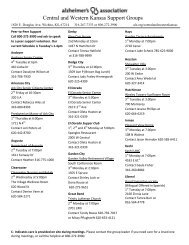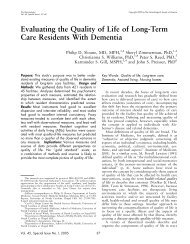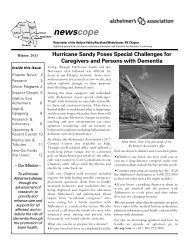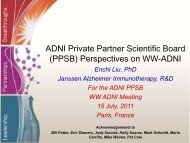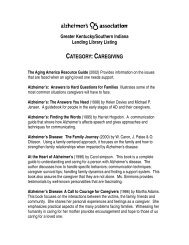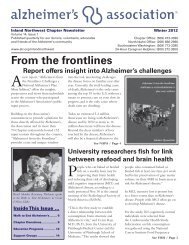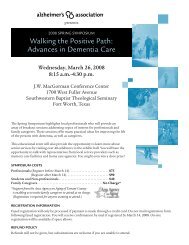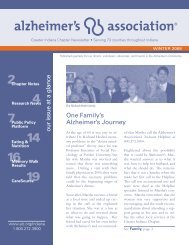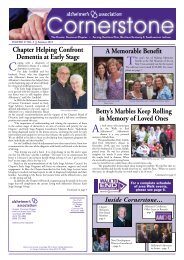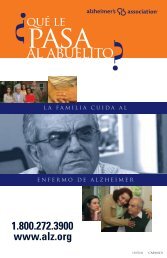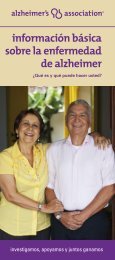First Line Treatment - Alzheimer's Association
First Line Treatment - Alzheimer's Association
First Line Treatment - Alzheimer's Association
Create successful ePaper yourself
Turn your PDF publications into a flip-book with our unique Google optimized e-Paper software.
11/25/2013<br />
Models of non-pharm intervention<br />
Models cont. (Unmet Needs)<br />
• Cohen-Mansfield (2004) does an excellent job<br />
of explaining the three theoretical models<br />
have generally been applied:<br />
– 1) the “unmet needs” model;<br />
– 2) a behavioral/learning model;<br />
– 3) an environmental vulnerability/ reduced stressthreshold<br />
model.<br />
• Significant proportions of nursing home<br />
residents who present inappropriate<br />
behaviors suffer from sensory deprivation,<br />
boredom, and loneliness.<br />
• Therefore, providing sensory stimulation,<br />
activities, and social contacts are among the<br />
most commonly described interventions.<br />
• A more insightful approach would be to<br />
prevent the patients from reaching the point<br />
of unmet need and to assist these persons in<br />
fulfilling their own needs.<br />
Models cont. (Learning)<br />
• The behavioral model assumes that a connection<br />
between antecedents, behavior, and<br />
reinforcement has been learned<br />
• A different learning experience is needed to<br />
change the relationship between antecedents<br />
and behavior (the ABC model= Antecedents-<br />
Behavior-Consequences; where antecedents<br />
operate through stimulus control, and the<br />
consequences reinforce behavior, or reinforce<br />
certain behavior related to specific<br />
antecedent/stimuli).<br />
• Many problem behaviors are learned through<br />
reinforcement by staff members, who provide<br />
attention when problem behavior is displayed. A<br />
modification of reinforcement contingencies is<br />
Models cont. (Environment)<br />
• <strong>Treatment</strong>s of reduced stimulation levels or provision of<br />
relaxation techniques (e.g., massage) are based on the<br />
assumption that the dementia process results in greater<br />
vulnerability to the environment and a lower threshold at<br />
which stimuli affect behavior.<br />
• Therefore, a stimulus that may be appropriate for a<br />
cognitively intact person may result in overreaction in the<br />
cognitively impaired person.<br />
• According to the concept of progressively lowered stress<br />
threshold, persons with dementia progressively lose their<br />
coping abilities and therefore perceive their environment<br />
as more and more stressful. At the same time, their<br />
threshold for encountering this stress decreases, resulting<br />
in anxiety and inappropriate behavior when the<br />
environmental stimuli exceed the threshold for stress.<br />
• An environment of reduced stimulation is supposed to limit<br />
the stress experienced and thereby reduce the level of<br />
Why use non-pharm interventions?<br />
The reasons for using a nonpharmacologic interventions<br />
approach to treating inappropriate behaviors in dementia<br />
include the following:<br />
1) it aims at addressing the<br />
psychosocial/environmental underlying reason for the<br />
behavior, as documented in previous research;<br />
2) it avoids the limitations of pharmacological<br />
interventions, namely, adverse side effects, drug-drug<br />
interactions, and limited efficacy; and<br />
3) when medication is efficacious, it may mask the<br />
actual need by eliminating the behavior that serves as a<br />
signal for the need, thereby reducing the already<br />
compromised communication by the elderly person and<br />
limiting the caregiver’s ability to properly care for him or<br />
her.<br />
Helpful steps for BPSD<br />
BPSD = Behavioral and Psychological Symptoms of Dementia<br />
1. Identify the target BPSD<br />
• There needs to be a clear definition of the problem to be<br />
addressed. The more clearly this is defined, the more likely<br />
caregivers will be able to identify a clear course of action.<br />
• Collaboration with the caregiver is essential.<br />
• Better to tackle one BPSD at a time.<br />
3




